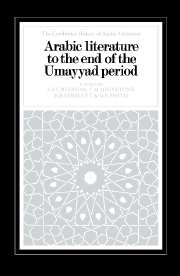Book contents
- Frontmatter
- Contents
- Editorial introduction
- 1 The tribes of pre-Islamic Arabia
- 2 The Umayyad Empire, c. A.D. 750
- 1 Background topics
- 2 Pre-Islamic poetry
- 3 Early Arabic prose
- 4 The beginnings of Arabic prose literature: the epistolary genre
- 5 The role of parallelism in Arabic prose
- 6 The Qur'ān-I
- 7 The Qur'ān–II
- 8 Qiṣaṣ elements in the Qur'ān
- 9 Aspects of the Qur'ān today
- 10 Ḥadīth literature–I: The development of the science of Ḥadīth
- 11 Ḥadīth literature-II: Collection and transmission of Ḥadīth
- 12 Shī'ī Ḥadīth
- 13 Narrative elements in the Ḥadīth literature
- 14 European criticism of Ḥadīth literature
- 15 The impact of the Qur'ān and Ḥadīth on medieval Arabic literature
- 16 The Maghāzī literature
- 17 The Sīrah literature
- 18 The poetry of the Sīrah literature
- 19 Fables and legends in pre-Islamic and early Islamic times
- 20 Umayyad poetry
- 21 Music and verse
- 22 The Greek impact on Arabic literature
- 23 The Persian impact on Arabic literature
- 24 The Syrian impact on Arabic literature
- Appendix Bibliography of translations of the Qur'ān into European languages
- Glossary
- List of sources
- Index
1 - Background topics
Published online by Cambridge University Press: 28 May 2012
- Frontmatter
- Contents
- Editorial introduction
- 1 The tribes of pre-Islamic Arabia
- 2 The Umayyad Empire, c. A.D. 750
- 1 Background topics
- 2 Pre-Islamic poetry
- 3 Early Arabic prose
- 4 The beginnings of Arabic prose literature: the epistolary genre
- 5 The role of parallelism in Arabic prose
- 6 The Qur'ān-I
- 7 The Qur'ān–II
- 8 Qiṣaṣ elements in the Qur'ān
- 9 Aspects of the Qur'ān today
- 10 Ḥadīth literature–I: The development of the science of Ḥadīth
- 11 Ḥadīth literature-II: Collection and transmission of Ḥadīth
- 12 Shī'ī Ḥadīth
- 13 Narrative elements in the Ḥadīth literature
- 14 European criticism of Ḥadīth literature
- 15 The impact of the Qur'ān and Ḥadīth on medieval Arabic literature
- 16 The Maghāzī literature
- 17 The Sīrah literature
- 18 The poetry of the Sīrah literature
- 19 Fables and legends in pre-Islamic and early Islamic times
- 20 Umayyad poetry
- 21 Music and verse
- 22 The Greek impact on Arabic literature
- 23 The Persian impact on Arabic literature
- 24 The Syrian impact on Arabic literature
- Appendix Bibliography of translations of the Qur'ān into European languages
- Glossary
- List of sources
- Index
Summary
THE EVOLUTION OF THE ARABIC LANGUAGE
In the first half of the first millennium A.D., the landmass bounded by the fringes of the Anatolian highlands, the eastern Mediterranean seaboard, the coasts of the Arabian Peninsula, and the western escarpment of the Iranian plateau, was the home of a family of languages now commonly termed Semitic. Intruding into the area were Greek-speaking populations within the boundaries of the Roman–Byzantine empire, and Middle Persian within those of the Sasanian empire; outside it, the Aksumite kingdom of Ethiopia also used a Semitic language. While the various members of this language-family are differentiated from each other in detail as sharply as are European languages such as French and Spanish, they exhibit general similarities which set them off, as a group, from languages such as Persian, which belongs to the Indo-European language-family.
By the early centuries A.D., two of the most important members of the Semitic language-family had virtually disappeared from the scene: Akkadian, the ancient language of Mesopotamia, was extinct; and Hebrew remained only as a learned and liturgical language no longer in everyday use. But two other important languages still dominated the area culturally. In the north, there was a cluster of Aramaic dialects, two of which have special significance, namely Syriac (used by the Christian populations of Syria and Mesopotamia) and Nabataean (used by pagan populations centred on the great caravan city of Petra). In the south, present-day Yemen was the home of an antique culture, of which the dominant representative was the kingdom of Saba (Sheba). The Sabaic language of pre-Christian times shows sufficient distinctive characteristics to warrant us in treating it as an independent language within the Semitic family.
- Type
- Chapter
- Information
- Arabic Literature to the End of the Umayyad Period , pp. 1 - 26Publisher: Cambridge University PressPrint publication year: 1983



